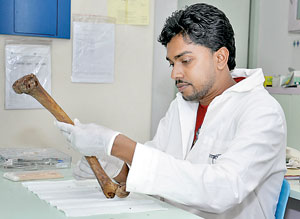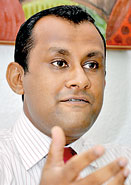From identifying suspects in the high profile murder of High Court Judge Sarath Ambepitiya, to identifying the remains of body parts of nearly 70 sailors killed in a suicide bomb blast in 2006 at Digampathana, DNA (DeoxyriboNucleicAcid) analysis has been used to convict murderers, as well as identify persons injured beyond recognition.
While the use of gene technology is comparatively new to Sri Lanka, today it is being used widely by the Courts in both criminal and civil cases, helping to identify suspects charged with murder, rape, robbery, industrial sabotage as well as in cases of divorce, where paternity tests have become surprisingly routine.
 |
| DNA tests being carried out (pictured below too) at Genetech.
Pix by Susantha Liyanawatte |
 |
Much of the work in connection with analysing DNA is being done by Genetech Molecular Diagnostics in Colombo, which has, since its inception in 1999, assisted the Police and courts in successfully prosecuting criminals in more than 1,700 cases, including the suspect in the Royal Park murder case.
“We have been called to analyse hair shafts to cigarette butts and human faecal matter, to identify suspects in criminal cases. It’s a challenging task,” Senior Scientist at Genetech, Dr. Ruwan Illeperuma said.
The collection of samples from scenes of crimes in a prompt and proper manner, as well as storage are crucial factors if a successful DNA analysis is to be carried out, to bring about conclusive results, and here, Police play the most important role.
“In the past 10 years, we have trained around 8,000 policemen on collection and storing of samples from the scene of a crime. The special Crime Scene Investigation personnel are now well experienced in gathering the necessary samples, without contaminating them,” Dr Illeperuma explained.
As body parts can degenerate rapidly in the hot, humid temperatures in Sri Lanka, speedy collection and storage is vital, and in many cases, the Police have recovered vital DNA based particles that became important evidence in Court.
In the Ambepitiya murder case, it was the analysis of a sample of vomit that the police found at the scene of the shooting, that led to the positive identification of one of the suspects, which in turn, led to the conviction of the assailants. “We discovered from the sample that the person had been under the influence of alcohol, and by analysing the mucus remains in the vomit, we obtained a DNA profile. It was matched with the DNA of the six suspects who were arrested. Our profile matched one of them,” Dr. Illeperuma explained.
Similarly, after the deadly suicide bombing at Digampathana in 2006, in which nearly 200, mainly Navy personnel were killed, nearly 70 of the dead could not be identified, as they had had been blown to bits. “We had to analyse the samples of body parts and also get blood samples from close relatives, to check against our results, to positively identify the dead,” he said.
In most cases, the request for a DNA analysis comes via a court directive. The process of sending samples is done in a highly confidential manner, and is stored strictly based on a coding system, so that, those doing the tests are unaware of the details involving a case. “We have to ensure a high level of confidentiality, both in criminal and civil cases, as our findings have to be defended in court by us,” Dr Illeperuma said. When a DNA profile is led as evidence, a scientist from the institute has to appear as witness to defend the accuracy of the DNA findings and face cross examination.
Paternity tests using DNA technology has also become regular in divorce cases involving adultery, with 20-40 cases being referred by the courts each month. When a DNA test is done to verify the paternity of a child, it is mandatory that both parents and the child are present at the same time. The samples are taken in the presence of all of them, as well as two witnesses, and the samples are sealed with the written consent of the parents. “In 80% of the cases, the husbands are the biological fathers. But due to suspicion, they choose to undergo the test,” he said.
 |
| Dr. Ruwan Illeperuma |
Paternity tests can also be done privately at Genetech. But, here too, the parents and the child have to be present together, as it is the legal requirement. “We have people who bring a hair from a child’s head and asking us to do a paternity test, which we refuse,” Dr Illeperuma said.
Some times people ask for paternity tests for strange reasons. In one instance, because the man was told by an astrologer, when the man went to get the child’s horoscope prepared, two weeks after his child was born, that he could not be the father of this child, he wanted a paternity test done. With the consent of the wife, the test was done, and it was proved that he was the father, he said.
“Maternity tests using DNA are done especially in cases where there has been a mix-up of a newborn in hospital, or abductions, but these are rarer than paternity tests,” he explained.
A DNA profile could take two weeks to eight months to finalise depending on the samples received. “If it’s a blood sample, it can be done easily. But in cases where body parts are exhumed after many months or several years, the process is more exhaustive,” Dr Illeperuma explained“Genetech has now set up a DNA bank with DNA profiles of nearly 3,000 criminals, which could be matched against the DNA of suspects arrested for various crimes in the future,” he added.
What is DNA?
DNA, or deoxyribonucleic acid, is the hereditary material in humans and almost all other organisms. Nearly every cell in a person’s body has the same DNA. Most DNA is located in the cell nucleus (where it is called nuclear DNA), but a small amount of DNA can also be found in the mitochondria (where it is called mitochondrial DNA or mtDNA).
The information in DNA is stored as a code made up of four chemical bases: adenine (A), guanine (G), cytosine (C), and thymine (T). Human DNA consists of about 3 billion bases, and more than 99 percent of those bases are the same in all people. The order, or sequence, of these bases determines the information available for building and maintaining an organism, similar to the way in which letters of the alphabet appear in a certain order to form words and sentences.
DNA bases pair up with each other, A with T and C with G, to form units called base pairs. Each base is also attached to a sugar molecule and a phosphate molecule. Together, a base, sugar, and phosphate are called a nucleotide. Nucleotides are arranged in two long strands that form a spiral called a double helix. The structure of the double helix is somewhat like a ladder, with the base pairs forming the ladder’s rungs and the sugar and phosphate molecules forming the vertical sidepieces of the ladder.
An important property of DNA is that it can replicate, or make copies of itself. Each strand of DNA in the double helix can serve as a pattern for duplicating the sequence of bases. This is critical when cells divide because each new cell needs to have an exact copy of the DNA present in the old cell.
DNA is a double helix formed by base pairs attached to a sugar-phosphate backbone.
Courtesy Wikipedia |




